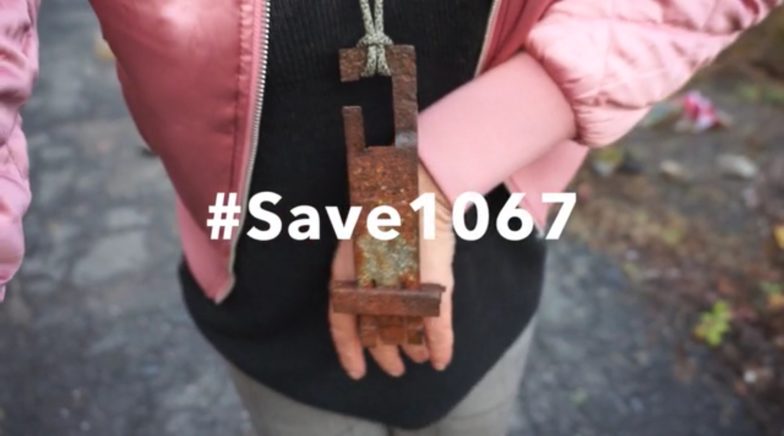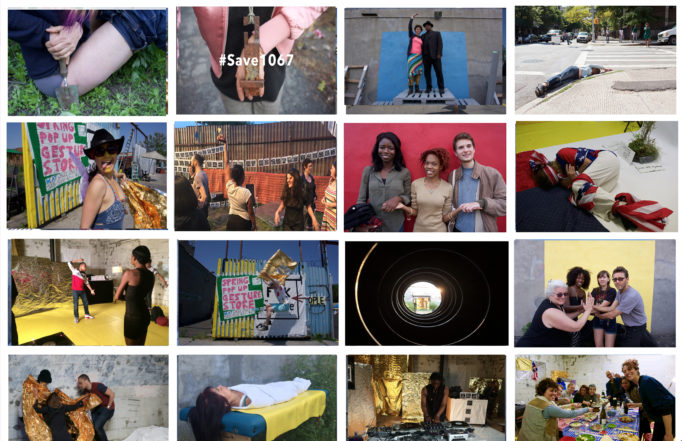Interview with Andrea Haenggi by Sara Bissen
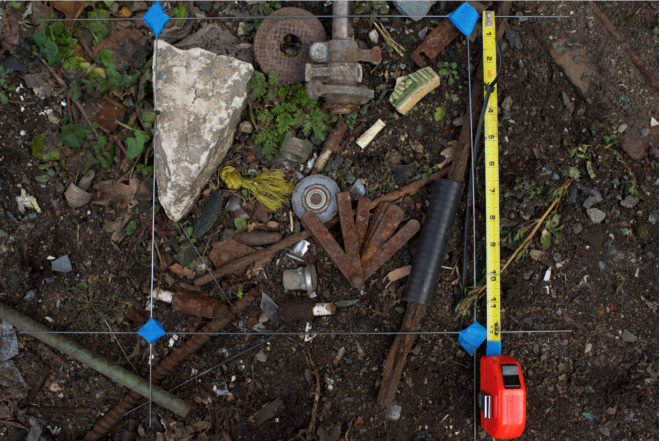
Soil and artifacts in a 1 X 1 ft. square at 1067 Pacific Street. (Image courtesy of 1067 PacificPeople.)
I walked into the Scenic Superficial Garage Resort at 1067 Pacific Street in Brooklyn on a hot, dusty day in early September 2013. The place was a raw urban prairie with a garage at the far end. Looking around, I noticed a tent next to a rusted corrugated metal wall. I ducked inside and found a library of unusual books: Ends of the Earth: Land Art to 1974 by Philipp Kaiser, and A Primer for Movement Description: Using Effort/Shape and Supplementary Concepts by Cecily Dell.
In the garage, methodological notes gleaned from Johann Wolfgang von Goethe shared space with Laban Movement Observations on large discarded plexiglass sheets that leaned against the cinder-block wall.
Goethean Science as a Way to Read Landscape
1. Exact Sense Perception [ bare facts ] seeing form
2. Exact Sensorial Fantasy [ imagination ]
[ see the phenomenon in time patterns, inner process ]
3. Seeing in Beholding [ inspiration ] inviting inspiration to … reveal the gesture
[ articulate the thing its own way ]
4. Being One With the Object [ intention ] [ combine and go beyond ]
On a temporary wood floor, an array of maps, drawings, numbers, and gallons of water offered a Goethean entry into the reality of bodies crossing from Mexico and Central America to the U.S. through the arid borderlands of the Southwest. On a table nearby, there were postcards—and if one chose to write someone, it could be mailed anywhere in the world.
I went back to the tent to study A Primer for Movement Description. Andrea Haenggi, the artist/choreographer/performer who created this movement encounter and installation, joined me inside and taught me how you can observe non-verbal language through the method of Laban Movement Analysis. Outside, another visitor relaxed in a beach chair, content to contemplate and feel the space. The performance, I realized, was up to us. The Scenic Superficial Garage Resort was meant to allow people to relate and take time—something at odds with daily life in New York City and the increasing hyper-reality of a society where people no longer look each other in the eye, whether or not they are paid or unpaid to do so.
There was a feeling of desert—and of being free. The time spent at 1067 PacificPeople brought the world closer, whether far or near.
VALUE AND RISK
The Scenic Superficial Garage Resort was part of 1067 PacificPeople, a 5-year live-performance experiment initiated by artist, choreographer, and performer Andrea Haenggi (along with writer Robert Neuwirth) on the site of a former auto repair yard and garage in Crown Heights, Brooklyn.
In a city and a society where free spaces are becoming few and far between, the people at 1067 are challenging the dominant concept of value that is based solely on economic exchange.
The experiments at 1067 have been varied: a series of provocatively themed ‘Pop Up Gesture Stores’ (one of them was called We Won’t do it Without the Flesh, another Vocabulary of Uncivilized Potential) in which customers purchased gestures and paid for them by giving a gesture back, feral workshops such as Green Borderland: A Walking Tour to Explore the Movement and Hues of an Urban Plant Community, several Pickpocket Dance Parties, in which revelers actually learned the skill of lifting cash (a metaphor, perhaps, for the various ways society continually pickpockets you), and, of course, the Scenic Superficial Garage Resort (subtitled, ‘rehearse knowing’ and ‘rehearse affection.’) Andrea also invites other artists from diverse fields to create immaterial dance encounters which are often uncomfortable and challenging for viewers. The philosophy of 1067 PacificPeople is that once you enter, you become part of the exchange: that’s the ‘gesture economy’ in action.
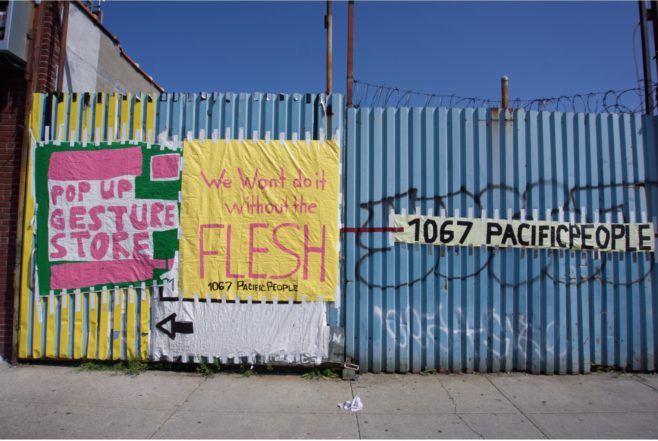
Gate at 1067 PacificPeople. (Image courtesy of 1067 PacificPeople.)
No matter how divergent in form, the array of encounters at 1067 Pacific Street reveal a particular focus: a re-evaluation of body, feeling, presence, and memory as a way to give room to the immaterial value of life.
I spoke with Andrea on December 12, 2016 to discuss this concept of value—which is a key element in her artistic practice.
Value, Andrea says, can be immaterial as well as material. “What I really value is the one-to-one, the life connection, the life experience. What is important for me is the immaterial without a lasting product. Live performance as life-performance.” She describes different facets of value: “raw value, superficial value, simulated value, emotional value, ruderal value, hot and cold value, the value of a physical movement, the value of a person, and the value of the immaterial as the general category that sets the value of love.”
Through the body, Andrea says, we come to our shared humanity. “Really seeing and feeling the other can be scary. Intimacy and presence are ideas that challenge. People have to take risk. There’s a tension, a sense of discomfort. That’s natural. But by paying attention and listening through the body, trust can emerge.”
ENCOUNTER AND PRESENCE
When 1067 PacificPeople started, four years back, Andrea called the first piece presented there a ‘value encounter.’ The work was durational. Andrea and the Australian performance artist Mick Douglas walked for 10 hours and 67 minutes, 2 days in a row, each carrying a backpack and a worn out automobile tire. They walked the space in silence, the weight of the tire and backpack connoting, perhaps, the importance of memory. Andrea describes their live-performance as an act of friendship, communicated through movement, gestures, touch, and sharing.
After walking for 10 hours 67 minutes, Andrea notes, the body gains a kind of immateriality. “My biggest value is the immaterial aspect of body interaction—connectedness among each other. It’s based on movement, gestures, and touch. The immaterial as a value—in the moment—and value as presence in itself.”
Andrea visited the Occupy Wall Street encampment at Zuccotti Park in New York during the first few days of the occupation. “It smelled like humanity,” she says. “Each person expressed themselves in their own way, but it was a collective. This made me realize how much I myself had lost that sense of time, love, presence, and togetherness. I think this is a deep human issue.”
We often use the digital world as a kind of hyper-suck over life and intentions, where relations get lost among “likes” and an ever-growing number of emoticons that express emotion by draining it of inner meaning. With one quick click, we think we are dealing with our feelings and being.
Andrea speaks of touch and information, adding that “being in the presence of someone else requires attention—its own kind of value. The value of time. The value of silence. Paying attention in interaction allows people to become comfortable with each other, to trust each other. It’s a trust exercise.” The value of listening. In the moment, it can be uncomfortable. But as Andrea says, an action reaches its target if it is done with a certain intent. The effect resonates.
MEMORY AND MOBILITY
The previous owner of 1067 Pacific leased space in the lot to freelance mechanics. “They were all independent. They had their own clients. The new landlord kicked them all out, but still, around 5 or 6 independent car repairmen remain on the block. They work on the sidewalk as ‘mobile’ repairmen.”
The local community board is currently promoting the idea of rezoning the area (currently set for manufacturing, the proposed new zoning will allow luxury housing). Andrea attended a meeting and discovered that the city’s official survey of the businesses on the block didn’t represent these street mechanics. “They did not qualify as a ‘legitimate’ business because they were on the street or working out of a little shack,” she says. “For the city, it’s as if they don’t exist. That’s [the pressure of] real estate.”
Andrea knows all of them. She ticks off some of their names: “Hollywood, Milton, Strength, Soldier: they have served their clients, mostly Caribbean and African, for years. Now the neighborhood, through real estate development, is becoming whiter and whiter. More and more, the repair people on the street have needed to leave because of real estate. But the soil remembers them.”
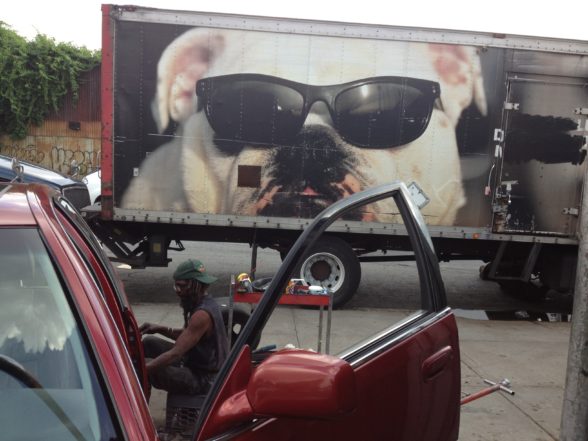
Hollywood, at work on a car—on the 1067 Street block. (Image courtesy of 1067 PacificPeople.)
“The neighborhood is changing. But many are still here. (Soldier, unfortunately, has been forced off the block.) They are vulnerable but they are proud and resilient.”
A hundred years back, lots like the one she rents had houses on them. “We found this out by digging through 1 meter of soil, and coming upon the remnant of a concrete foundation. Then we met a man who was cleaning his car on the street who told us that he grew up on the block. He told us that it was pretty fancy, with a cinema and many houses.” Andrea and Rob also discovered old ‘positions wanted’ ads in the Brooklyn Eagle, a long-defunct daily newspaper, from people—mostly African-American—who lived at 1067 Pacific and were searching for jobs as maids and laborers.
THE NON-HUMAN AND THE WEEDS
Andrea’s practice at 1067 PacificPeople acknowledges that non-human things claim space, too. Weeds—plants considered undesirable, or in the wrong place—grow vigorously and adapt rapidly to changing conditions. And objects inhabit the earth.
Upon signing the lease for 1067, Andrea framed out a series of 25 1 ft. x 1 ft. squares. “The first thing Rob and I did was take pictures of these squares, without touching anything.” Then the process of unearthing began. First pulling countless shards of broken glass from the soil. And then heavier items. “I noticed these industrial automotive and iron objects on top and under the soil. In the attempt to free the soil from heavy metals, I decided to take them out and collect them. I put them all in a huge box, full of so many things—some of them very heavy.”
The process seems never-ending. A few days after removing objects from the soil, more remnants seem to emerge.
“What’s the history?” Andrea asks. “Is there value? Is there decay? Do they hold information about who was here before, who touched and used them?” It’s fascinating how the body leaves no trace, but the soil holds everything.
Despite all the glass and metal in the soil, plants continue to sprout. To pursue their voices, Andrea spends time and makes situations with the urban spontaneous plants that sprout at 1067 Pacific Street. In some of her latest works, “the plant is the artist. The plant Artemisia vulgaris [mugwort] has a story for you.” Andrea suggests that we can begin “to better understand the life of plants by taking them as a form of thinking, and moving with them.” The urban spontaneous plants, the plants we call weeds, she says, “actually have something to say.”[1] She smells the weeds, and would say that the smell of the plants helps her create an image, and a memory. “I wait until the plant tells me something. We facilitate every month on the 4th Tuesday a 3-hr Collective Weed Improvisation Jam. Each time, a different movement facilitator leads the participants in experiencing the weeds.”
In order to understand the weeds, Andrea suggests we need to sensitize ourselves through smell, touch, taste, and seeing. “Just think of the fact that the plant dies every year, and the seed moves to another place. Some seeds stay underground and in the soil for years. Even if you put concrete over it, the seed waits. A tiny crack in the concrete can be enough for it to spring to life. Weeds are opportunistic. Weeds don’t need us. They are very resilient. What if I take that weed-thinking into my life? What if, in reality, we all are weeds? Weedy people. Weedy society.”
SAVE 1067
A place dedicated to the immaterial needs material support to survive, and 1067 PacificPeople is now relying on the wider community to step into the space with them.
As a fundraiser for the coming year, Andrea has created Historical Artifact Jewelry to Save 1067. These artifacts come from the collective soil of the site. “When I wear them,” she says, “I can feel their heaviness. Their weight. That represents the struggle that people went through—and that the items themselves went through being buried for so long. There is even some dirt on them, sealed onto the surface with a coating of clear nail polish. They are real. They exist. I send them with a little text, a certification that tells their story. That’s why it’s a ‘Historical Artifact.’ Waste material takes my energy, my warmth. It is energized by my energy. The experience given by these objects is immaterial and valuable.”
The call from 1067 PacificPeople is: “We question value. We look for weedy and wild new ways to be together. We decide what is valuable—together. All of us, human and non-human together. We create immaterial values.”
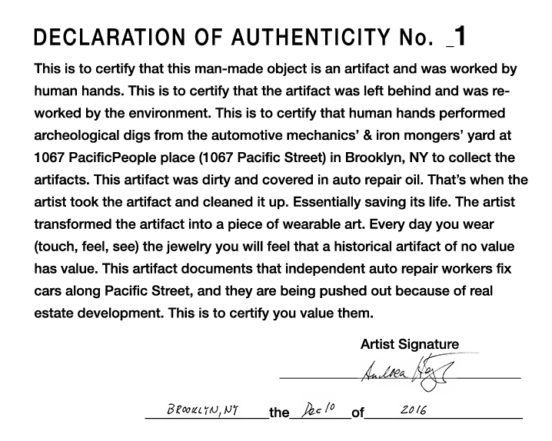
Declaration of Authenticity by the artist, with the Historical Artifact—signed and numbered.
Upcoming 2017 will include an experimental Performance Festival, a Weedy Society research lab, and a place for coming together in “sanctuary” and connection.
Footnotes:
[1] For additional thoughts on the plants, see Neuwirth, R. (2016). 1067 Pacific St., Brooklyn: In the Ruderal City. Journal of Biourbanism, IV (1&2/2015), 19−24.
